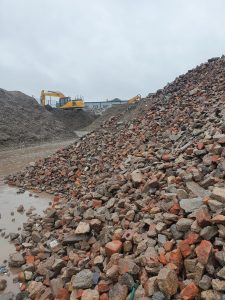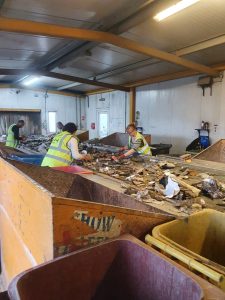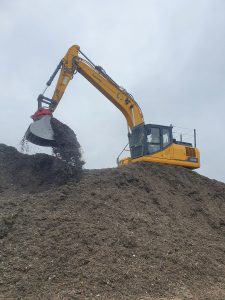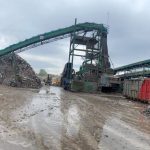Here at Kenny Waste Management, we regularly service some of the largest developers and construction companies in the UK, including Morgan Sindall, Countryside Properties and Wilmott Dixon. Therefore, we deal with a significant amount of aggregate and fines.
Aggregate can include brick, concrete, tiles, glass, and stone. These materials are 100% inert and don’t biodegrade over time. As such, they are perfect to crush into a product called 6F2. However, before this can happen, aggregate must be processed within our state-of the-art facility to ensure that it meets the required standards. Crushed aggregate is the only material that leaves our facility as a product, rather than waste. Therefore, it must be tested to confirm its compliance, before being sent to construction sites across the North-West.

To meet the required standards, aggregate is put through our separation plant and streamed as clean, loose aggregate.
After being initially separated, we transfer the aggregate to the pre-crush pile at the rear of our facility. The materials then go through a crusher where it is reduced in size to around 100mm. To ensure that our finished product is of a high quality, we produce our 6F2 to UKAS standards and in accordance with the WRAP Protocol. This means that the product has the right blend of materials and sizes to pass the UKAS test and be suitable for use as a sub-base.

We also receive a large amount of fine and granular material from our customers. Fine material is separated within a series of trommels after entering our mechanical plant. Material smaller than 20mm gets sent to our fines clean-up plant to be cleansed by a series of blowers, shakers and screens. Therefore, materials, such as stones, can be removed from the waste stream and moved to the aggregate pile. As well as this, small fragments of light material will also be removed at this stage.
After all of this processing, we are left with a soil like material made up of a variety of inert wastes and a small amount of organic material. Restoration sites use this as a fill or daily cover. Fine material is not soil and therefore cannot be moved or sold as soil. It is waste and leaves our facility as such.

Fines and crushed aggregate can be seen getting collected from our facility on a daily basis. This allows us to service our customers in a first-class way, whilst diverting over 99% of the total waste that we collect from landfill. The processes described above are a perfect example of Kenny Waste Management putting products to another use.
Look out for the next blog in the series where we will continue to explain what happens to your waste after it is collected.


